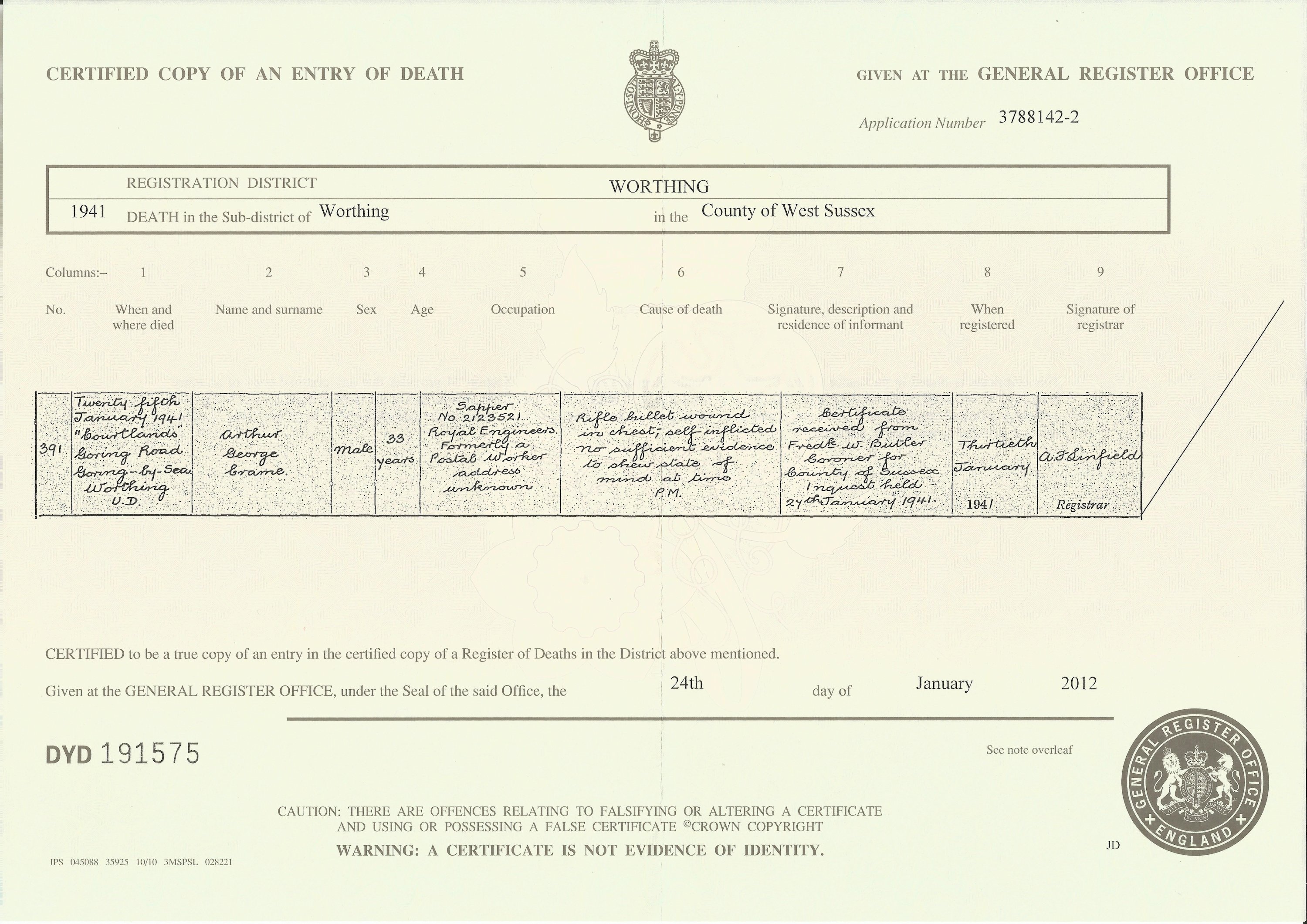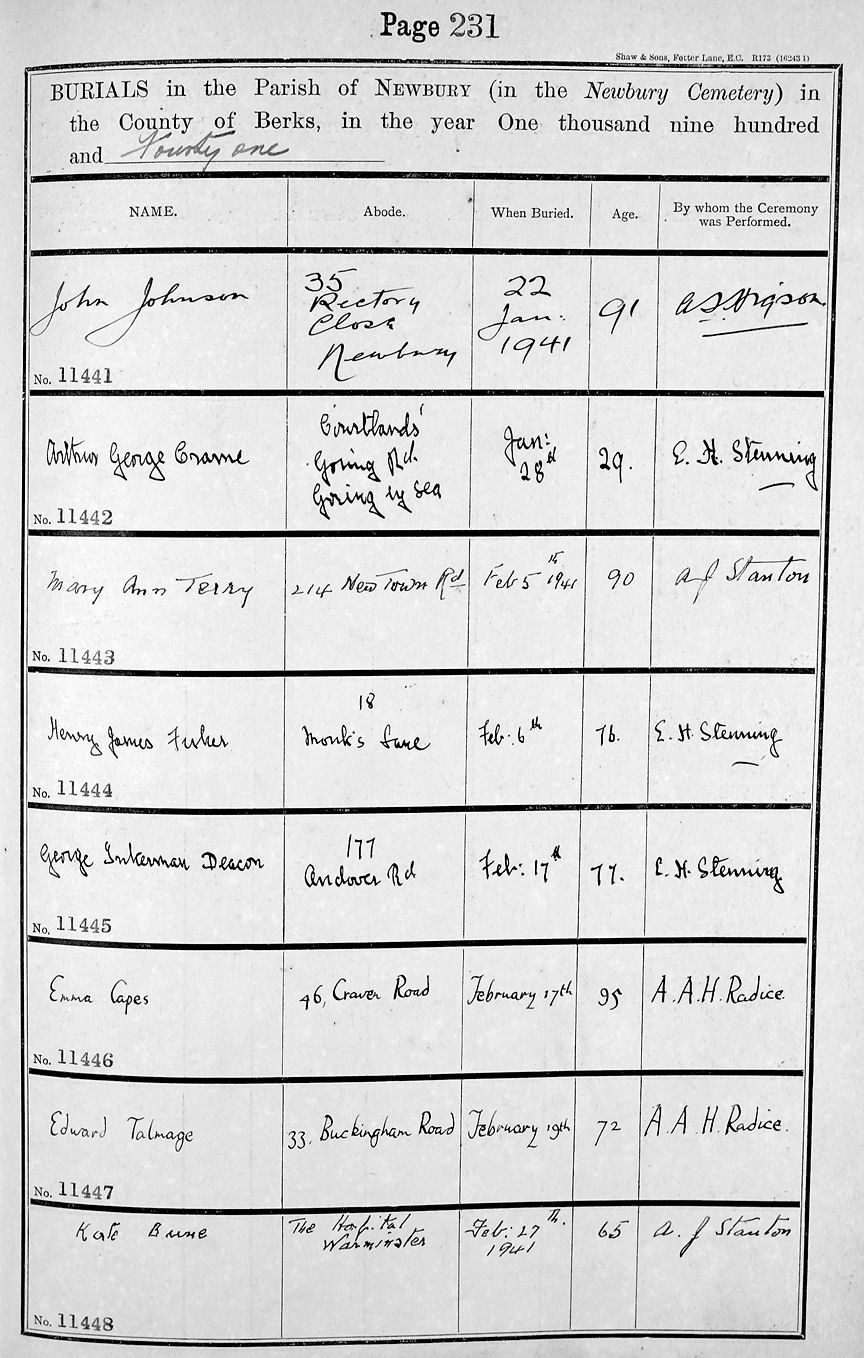
Personal Details of Arthur George Crame
| Born: | |
| Died: | 25/01/1941 |
| Buried: | 28/01/1941 |
Listed below are all the details we have been able to find so far on Arthur George Crame.
As far as we are aware, all the information is correct. However, sometimes transcriptions can lead to errors being made. If you find any errors or omissions, please let us know and we will endeavour to get them corrected as soon as possible.
If you have any further information on Arthur George Crame, we would be delighted to hear from you.
Commonwealth War Grave
The Grave of Arthur George Crame is a Commonwealth War Grave.
It is maintained by the Commonwealth War Graves Commission
| Name: | Arthur George Crame |
| Service: | Royal Engineers |
| Service number: | 2123521 |
| Rank: | Sapper |
| Date of death: | 23/01/1941 |
| Age at death: | 29 |
| Other information: | Son of Emily Emma Crame, of Newbury. |
| Link to Commonwealth War Grave Commission entry: | Click Here |
| Link to West Berkshire Memorials entry: | Click Here |
Birth
There is no information in our database regarding the birth of Arthur George Crame.
Can you help us? If so, please contact our History Research Group.
Death
| Name at death | Arthur George Crame | ||||||||||||
| Date of death | |||||||||||||
| Age at death | 33 | ||||||||||||
| Gender at Death | Male | ||||||||||||
| Cause of Death | Rifle bullet wound in chest, self-inflicted. No sufficient evidence to show state of mind at time. P.M. | ||||||||||||
| Place of Death | Courtlands, Goring Road Goring-by-Sea, Worthing | ||||||||||||
| Usual Address | |||||||||||||
| GRO certificate index |
|
||||||||||||
| Information Sources | Death Certificate, Free BMD | ||||||||||||

Death certificate for Arthur George Crame*
Provided by FNRC
Burial Register
| Name at death | Arthur George Crame | ||||||
| Age at Death | 29 | ||||||
| Burial Date | 28 January 1941 | ||||||
| Abode |
Courtlands, Goring Road
Goring-by-Sea |
||||||
| Official at Burial | E.H. Stenning | ||||||
| Comments | |||||||
| Burial Register Index |
|
||||||
| Sources | Burial Register |
Memorial Details
| "On S kerb slope: In Loving Memory of Arthur George Crame, died Jan. 23: 1941 aged 30.// On W end: At rest.//" | |
| Name on Memorial | ARTHUR GEORGE CRAME |
| Date of death | 23/01/1941 |
| Age | 30 |
| Gender | Male |
| Memorial Type | Kerbstones with flower holder |
| Construction Material | Granite |
| Condition of memorial | Kerbstones with corner pillars and flower holder. Lettering |
| Pattison Location Code | Ch34 |
Newspaper Cuttings
The articles below have been transcribed from newspapers and magezines.
Arthur George Crame
| Source: | Worthing Gazette |
| Article date: | 29/01/1941 |
| Copyright: | Worthing Herald |
| Transciption: | ARTHUR GEORGE CRAME
SOLDIER DEAD IN POOL OF BLOOD AT BILLET
The story of a soldier who was found lying dead in a pool of blood in his room with a rifle besides him was told at the at Worthing Town Hall on Monday. He was Sapper Arthur George Crame, whose age was estimated at 33, and he was stated to have been a postal worker, of Newbury.
It was revealed that he had been in the Army between two and three months. He was described as of a quiet and reserved disposition and a good worker. No light was thrown on what had led to his death.
Lieutenant Arthur Pearce said he was a member of a court of inquiry held on Friday relating to the death of Crame. He produced a copy of the proceedings.
SAPPER'S DISCOVERY.
Corporal Frederick Diggins said he on provost duty in the police room at about 10.10 p.m on Thursday. A sapper entered to report his return from leave. Then he left, and returning a few minutes later, informed witness that there was a man dead in his room.
"I went with him” continued witness, "and saw a sapper lying face downwards in a pool of blood.”
The Coroner (Mr. F. W. Butler): Was he clothed ?—Witness: Partially clothed, with slippers on. I touched the body and found it cold and stiff.
Is it a fact there was a rifle lying by his side?—Yes.
Which way was It pointing?—Towards the head.
Did you know the man?—Yes.
As Arthur George Crame?—Yes, commonly called " Bob.”
Had he been occupying that room with others?—Prior to the men being sent on leave, he had.
How long had he been alone?—About three days.
He added that he did not hear a report of a rifle.
MEDICAL EVIDENCE.
Captain John Clive Baird Nesfield, R.A.M.C., said that at about 10.30 on Thursday night he received a telephone message from the Adjutant asking him to go to the scene at once as he believed there had been an attempted suicide. Witness arrived at the room at 10.40 p.m., and was directed to a room on the top floor. The corporal told him the sapper appeared to be dead. The civil police and two members of the military police were already in the room.
The body, which was in a pool of blood, was dressed in shirt, trousers, and "gym." shoes. There was a rifle close to the left side. Rigor mortis was fully established.
In witness's opinion, the man had been dead at least four hours. Witness rolled the body over, and saw a wound in the front of the chest, and about three pints of blood had been spilt on the floor.
Witness produced an empty cartridge case and the Coroner asked if there were any more. Witness: No, sir. Lying on the bed was a bullet case bandolier, in which were 19 rounds of ammunition. In one of the clips one case was missing.
Witness went on to say he made a post mortem examination the following day and thought the deceased was about 33 years old. There were no external signs of corrosive poisoning. The left lung had collapsed and disintegrated.
In his opinion death was due to a missile having penetrated the chest and lung substance.
UNFINISHED LETTER
"A wound of this nature," added witness, "would cause such profuse haemorrhage that death would be instantaneous."
The Coroner: Do you know that he belonged to Newbury, and was a postman there ?—Witness : I knew he came from Newbury.
Witness mentioned that be found a letter which had only just been started, and another letter In the deceased's klt-bag.
The Coroner : Are you in a position to express an opinion as to whether the wound was self-Inflicted? Witness: Judging from the position of it, it rather suggests it was.
Referring to the letter found in deceased's kit-bag, witness said he was unable to say whether it was in the man's hand -writing.
The Coroner Prima facie, one might assume it was his writing.
Lieutenant Pearce told the Coroner the deceased was looked upon as a good worker. He joined up two-and-a-half to three months ago. There had been no trouble in the unit.
The Coroner returned a verdict that deceased died from a rifle bullet wound In the chest, self-inflicted, but there was not sufficient evidence to show the state of his mind at the time.
Major F. W. Heath, M.C.,R.E.,expressed the sympathy of the unit with the bereaved family, and the Coroner identified himself with these observations.
|
| This obituary entry is awaiting verification. |
Arthruy George Crame
| Source: | Worthing Herald |
| Article date: | 31/01/1941 |
| Copyright: | Worthing Herald |
| Transciption: | ARTHUR GEORGE CRAME
MYSTERY OF WHY SOLDIER TOOK HIS LIFE
SAPPER ARTHUR GEORGE CRAME WAS KNOWN AS " BOB" TO HIS ARMY PALS. WHEN HE WAS FOUND SHOT DEAD, A RIFLE BY HIS SIDE, IN THE HOUSE WHERE HE WAS BILLETED, A LETTER - JUST BEGUN AND NEVER FINISHED - LAY NEAR HIM. ANOTHER LETTER, DATED JANUARY 11th, AND NEVER POSTED, WAS IN HIS KIT BAG.
In civilian life Crame was a postman at Newbury. He was about 33 years of age, and joined the Army about ten weeks ago.
At the inquest at Worthing Town Hall on Monday, the Coroner (Mr P. W. Butler) stated that the letters appeared to have no bearing on the case.
Lieut. Arthur Pearce produced a copy of the proceedings of the Court of Inquiry, of which he was a member.
Corporal Frederick Diggins described how, when on duty at the house on Thursday last, he was informed that there was a man dead in one of the rooms. He saw Sapper Crame lying face downwards on the bed, partly clothed and wearing slippers. Witness touched the body and found it cold. A rifle lay by the side of the body. its muzzle pointing towards the head.
Heard No Report
Witness said he knew the dead man as Arthur George Crame, commonly known as "Bob." He had occupied a room with other men. but had had it to himself for the last two or three days, his companions having been posted away or granted leave. Witness had been on duty since 8 a.m., but had not heard the report of a rifle.
Captain John Clive Bair Nesfield, R.A.M.C.. stated that he received a telephone message from the Adjutant asking him to come at once. In a room on the top floor he found Sapper Crame lying face downwards in a pool of blood. He was wearing shirt, trousers and gymnasium slippers. The rifle was near his left side. In witness's opinion he had been dead for the last four hours.
Rolling the body over, witness saw a wound in the front of the chest, where a bullet had passed through his shirt. Such a wound would cause a profuse haemorrhage that would mean instantaneous death.
Letter in Kit Bag
One letter, dated the previous Sunday and only just started, lay beside him, said witness. Another letter, dated January 11th. was found in the kit-bag where he kept his equipment and personal belongings. "They don't show any bearing on thecae” remarked the Coroner, after examining the letters.
The Coroner asked Capt. Nesfleld whether he was in a position to express an opinion as to whether the wound could have been self-inflicted.
Captain Nesfield: I think, judging from the position of the wound, that it was self-inflicted.
It was stated that Sapper Crame was a keen worker and there had been no trouble in the unit.
The Coroner: I am satisfied that he did take his own life. There is no evidence as to what caused his act, so I cannot say what was the state of his mind at the time.
Major F. W. Heath, MC., expressed his sympathy with the bereaved family in terms wtth which the Coroner associated himself. |
| This obituary entry is awaiting verification. |
Biographical Information
There is no biographical information available for Arthur George Crame. If you have any information that could help us, please contact the History Research Group.
*The FNRC believe that the certificates published on this page have been added in compliance with the rules laid down by the General Register Office (GRO). Click here for more information.
If you believe that we may have inadvertently breached the privacy of a living person by publishing any document, please contact us so we can immediately remove the certificate and investigate further.
Thank you.
FNRC.
© 2010-2023. Friends of Newtown Road Cemetery, unless otherwise stated.
Web site designed by Paul Thompson
The Friends of Newtown Road Cemetery is a not-for-profit organisation that works in association with Newbury Town Council to look after and maintain Newtown Road Cemetery for the benefit of the people of Newbury.
